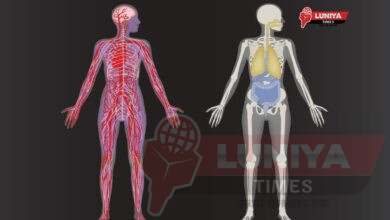
10 best topics on human body is an intricate marvel of biological engineering, composed of trillions of cells working in harmony to sustain life.
Today we will talk about 10 Best Topics on Human Body From the complex network of nerves that send signals at lightning speed to the complex system of organs that work tirelessly, every aspect of the body contributes to its remarkable abilities. . Bones provide structure and support, muscles provide movement, and the circulatory system pumps oxygen-rich blood to every corner. Meanwhile, the brain, the command center, organizes it all with astonishing precision. Yet, behind this complexity there is a vulnerability, a fragility that underlines the importance of caring for and respecting this incredible vessel that carries us throughout life.
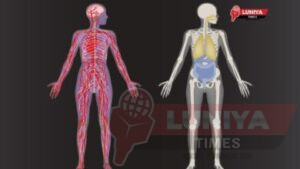
Immune System
Understanding the Immune System: Your Body’s Defender
The immune system is a complex network of cells, tissues, and organs that work together to defend the body against harmful invaders, such as bacteria, viruses, fungi, and parasites. It is one of the most intricate and fascinating systems in the human body, playing a crucial role in maintaining health and combating diseases.
The Components of the Immune System:
1. White Blood Cells (Leukocytes): These are the key players in the immune system, produced in the bone marrow and found throughout the body. There are two main types of white blood cells: phagocytes, which engulf and digest pathogens, and lymphocytes, which include T cells and B cells.
2. Lymphatic System: This network of vessels and organs, including the spleen, thymus, and lymph nodes, is responsible for transporting lymph (a clear fluid containing white blood cells) throughout the body. The lymphatic system plays a crucial role in filtering out pathogens and foreign substances.
3. Antibodies: These are proteins produced by B cells in response to specific pathogens. Antibodies bind to the surface of pathogens, marking them for destruction by other components of the immune system or neutralizing their harmful effects.
4. Complement System: This is a group of proteins that work together to enhance the immune response. The complement system can directly kill pathogens, trigger inflammation, and help to clear away dead cells and debris.
How the Immune System Works:
When the body encounters a foreign invader, such as a virus or bacterium, the immune system mounts a defense in a series of coordinated steps:
1. Recognition: Specialized cells of the immune system recognize and identify the invading pathogen as foreign.
2. Activation: Once recognized, the immune system activates a response tailored to the specific pathogen. This involves the production of antibodies, recruitment of white blood cells, and activation of other immune cells.
3. Attack: Effector cells of the immune system, such as T cells and phagocytes, work together to eliminate the pathogen. T cells can directly kill infected cells, while phagocytes engulf and digest pathogens.
4. Memory: After the infection is cleared, some immune cells remain in the body as memory cells. These cells “remember” the pathogen and enable a faster and more robust response upon future encounters, providing immunity.
Disorders of the Immune System:
While the immune system is highly effective at protecting the body, it can sometimes malfunction, leading to immune disorders. These disorders can result in an overactive immune response (autoimmune diseases), where the immune system attacks the body’s own tissues, or an underactive immune response (immunodeficiency disorders), where the body is unable to effectively combat infections.
Tips for Supporting a Healthy Immune System:
1. Maintain a balanced diet: A diet rich in fruits, vegetables, whole grains, and lean proteins provides essential nutrients and antioxidants that support immune function.
2. Get regular exercise: Moderate exercise can help boost the immune system by promoting good circulation and reducing stress.
3. Get enough sleep: Adequate sleep is crucial for immune function, as it allows the body to repair and regenerate.
4. Manage stress: Chronic stress can weaken the immune system, so finding healthy ways to manage stress, such as meditation or yoga, is important.
5. Practice good hygiene: Washing your hands regularly, avoiding close contact with sick individuals, and staying up to date on vaccinations can help prevent infections and support overall immune health.
Conclusion
the immune system is a remarkable defense mechanism that protects the body from harmful invaders. Understanding how the immune system works and taking steps to support its function can help maintain overall health and well-being.
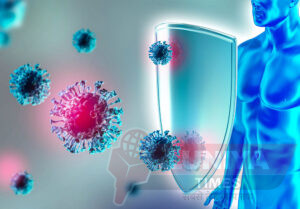
Lymphatic System
Understanding the Marvels of the Lymphatic System: A Comprehensive Overview
Introduction:
The human body is a marvel of complexity, with intricate systems working in tandem to maintain health and vitality. Among these, the lymphatic system stands out as a crucial yet often underappreciated component. Serving as the body’s sanitation department, the lymphatic system plays a pivotal role in immunity, fluid balance, and overall well-being.
Anatomy of the Lymphatic System:
The lymphatic system is a network of vessels, nodes, and organs that work together to transport a clear fluid called lymph throughout the body. Lymphatic vessels parallel blood vessels, reaching nearly every part of the body, with the exception of the central nervous system. Lymph nodes, small bean-shaped structures, act as filtration centers along these vessels, where immune cells monitor and combat pathogens.
Functions of the Lymphatic System:
1. Immunity: One of the primary functions of the lymphatic system is to defend the body against infections and diseases. Lymph nodes are filled with immune cells, such as lymphocytes and macrophages, which identify and neutralize harmful substances like bacteria, viruses, and abnormal cells. When pathogens are detected, lymphocytes launch an immune response, producing antibodies to target and destroy the invaders.
2. Fluid Balance: Another critical role of the lymphatic system is maintaining fluid balance within the body. While blood vessels deliver nutrients and oxygen to tissues, they also leak fluid into the surrounding spaces. The lymphatic vessels collect this excess fluid, along with proteins and waste products, and return it to the bloodstream. Without this drainage system, fluid would accumulate in the tissues, leading to swelling and edema.
3. Absorption of Nutrients: In addition to removing excess fluid, the lymphatic system assists in the absorption of dietary fats and fat-soluble vitamins from the digestive system. Specialized lymphatic vessels called lacteals absorb these nutrients from the small intestine and transport them through the lymphatic system to the bloodstream for distribution to cells throughout the body.
Common Disorders and Diseases:
While the lymphatic system is remarkably efficient, it can be susceptible to various disorders and diseases:
1. Lymphedema: This condition occurs when the lymphatic system is damaged or impaired, leading to swelling (usually in the arms or legs) due to fluid retention. Lymphedema can result from surgery, radiation therapy, infection, or genetic abnormalities.
2. Lymphadenopathy: Enlarged lymph nodes, known as lymphadenopathy, may indicate an underlying infection, inflammation, or cancer. While temporary swelling is often a sign of the immune system’s response to infection, persistent enlargement may require medical evaluation.
3. Lymphoma: Lymphoma is a type of cancer that affects the lymphatic system, specifically the lymphocytes. It can manifest as Hodgkin lymphoma or non-Hodgkin lymphoma, with symptoms such as swollen lymph nodes, fatigue, and unexplained weight loss. Early diagnosis and treatment are crucial for managing lymphoma effectively.
Conclusion:
The lymphatic system is a vital component of the body’s defense mechanisms and overall physiological balance. From safeguarding against pathogens to maintaining fluid equilibrium, its functions are indispensable for optimal health. By understanding the anatomy, functions, and potential disorders of the lymphatic system, we gain insight into the complexities of the human body and the importance of nurturing its natural defenses.
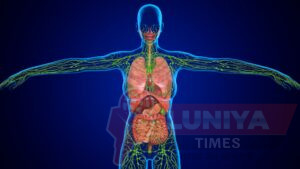
Sensory System
Understanding the Wonders of the Sensory System: A Journey Through Perception
Introduction:
The sensory system serves as the gateway to our perception of the world, enabling us to interact with our environment and make sense of the myriad stimuli that surround us. Comprising sight, hearing, taste, smell, and touch, this complex system forms the foundation of our experiences, shaping how we perceive reality and navigate our lives. In this article, we embark on a journey through the intricacies of the sensory system, exploring its marvels and uncovering the secrets of perception.
The Five Senses:
1. Sight (Vision): Vision is perhaps the most dominant of the senses, providing us with the ability to perceive shapes, colors, and movement. The eye, with its intricate structure including the cornea, lens, and retina, acts as a sophisticated camera, capturing light and converting it into neural signals that the brain interprets as images. From the vibrant hues of a sunset to the subtle expressions on a loved one’s face, sight enriches our understanding of the world around us.
2. Hearing (Audition): Sound is another essential component of human perception, allowing us to communicate, appreciate music, and be aware of our surroundings. The ear, with its delicate mechanisms such as the eardrum, cochlea, and auditory nerve, transforms sound waves into electrical signals that the brain interprets as sound. Whether it’s the melodious notes of a song or the rustle of leaves in the wind, hearing enhances our experiences and connects us to the auditory tapestry of life.
3. Taste (Gustation): The sense of taste enables us to discern the flavors of the foods we consume, adding richness to our culinary adventures. Taste buds located on the tongue and other parts of the mouth detect basic tastes such as sweet, sour, salty, bitter, and umami, sending signals to the brain for interpretation. From the tangy zest of citrus fruits to the savory goodness of a perfectly grilled steak, taste tantalizes our palate and brings pleasure to our dining experiences.
4. Smell (Olfaction): Olfaction, or the sense of smell, plays a crucial role in evoking memories, triggering emotions, and alerting us to potential dangers. The nose, equipped with specialized olfactory receptors, detects odor molecules in the air and transmits signals to the brain’s olfactory bulb for processing. Whether it’s the nostalgic scent of freshly baked cookies or the pungent aroma of a blooming flower, smell adds depth to our perception of the world and influences our behavior.
5. Touch (Somatosensation): Touch is our primary means of physical interaction with the world, conveying sensations of pressure, temperature, and texture. The skin, the body’s largest organ, contains a vast array of sensory receptors that detect stimuli and transmit signals through the nervous system to the brain. From the gentle caress of a loved one’s hand to the comforting warmth of sunlight on our skin, touch fosters connection, intimacy, and sensory exploration.
Integration and Perception:
While each sense operates independently, the brain seamlessly integrates information from multiple sensory modalities to construct a unified perception of the world. This process, known as multisensory integration, allows us to form coherent representations of our surroundings and make informed decisions based on our sensory experiences. Whether we’re enjoying a delicious meal, marveling at a breathtaking landscape, or navigating through a crowded street, our perception is shaped by the dynamic interplay of sensory inputs and cognitive processing.
Conclusion:
The sensory system is a marvel of biological engineering, enabling us to perceive, interpret, and engage with the world in profound ways. From the splendor of a sunrise to the intricacies of human interaction, our senses enrich every aspect of our lives, shaping our experiences and influencing our perceptions. By understanding the complexities of the sensory system, we gain a deeper appreciation for the wonders of human perception and the remarkable capabilities of the human mind.
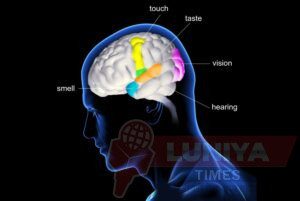
Brain Structure and Function
Unveiling the Intricacies of Brain Structure and Function: A Journey into the Marvels of the Mind
Introduction:
The human brain, with its labyrinthine complexity and awe-inspiring capabilities, stands as one of the most fascinating and enigmatic structures in the known universe. Comprising billions of neurons and trillions of synaptic connections, the brain serves as the command center of our thoughts, emotions, behaviors, and perceptions. In this exploration, we delve into the intricacies of its structure and function, unraveling the mysteries that underpin the marvels of the mind.
Understanding Brain Structure:
At its core, the human brain can be divided into distinct regions, each endowed with specialized functions. The cerebral cortex, the outermost layer responsible for higher cognitive functions, is divided into four lobes: the frontal, parietal, temporal, and occipital lobes. These lobes collaborate harmoniously, orchestrating processes ranging from decision-making and language comprehension to sensory perception and motor control.
Beneath the cerebral cortex lies an array of structures collectively known as the subcortical regions. These include the thalamus, hypothalamus, hippocampus, amygdala, and basal ganglia, among others. Each of these structures plays a pivotal role in regulating various aspects of behavior, emotion, memory, and movement, forming intricate neural circuits that underlie our everyday experiences.
The Brain in Action:
Functionally, the brain operates through a complex interplay of electrical and chemical signals, facilitating communication between neurons across vast networks. Neuronal communication occurs primarily through the release of neurotransmitters, which traverse synaptic gaps to bind with receptors on neighboring neurons, thereby transmitting information.
The brain’s remarkable plasticity enables it to adapt and reorganize in response to experiences and environmental stimuli. This phenomenon, known as neuroplasticity, underscores the brain’s capacity for learning, memory formation, and recovery from injury. Through mechanisms such as synaptic pruning and neurogenesis, the brain continually refines its neural connections, sculpting its architecture in accordance with ongoing demands and challenges.
Furthermore, the brain exhibits hemispheric specialization, with the left hemisphere typically governing language, logic, and analytical thinking, while the right hemisphere predominates in spatial awareness, creativity, and holistic processing. This lateralization of function confers a remarkable degree of efficiency, allowing for seamless integration of diverse cognitive processes.
Implications for Health and Disease:
An understanding of brain structure and function holds profound implications for addressing a myriad of neurological and psychiatric disorders. Conditions such as Alzheimer’s disease, Parkinson’s disease, schizophrenia, and depression are characterized by aberrations in neural circuitry, neurotransmitter imbalances, or structural abnormalities, highlighting the intricate interplay between brain biology and mental health.
Advancements in neuroimaging techniques, such as functional magnetic resonance imaging (fMRI) and diffusion tensor imaging (DTI), have revolutionized our ability to visualize and study the living brain in exquisite detail. These tools afford unprecedented insights into the neural correlates of various cognitive functions and disorders, paving the way for targeted interventions and personalized treatment approaches.
Conclusion:
The human brain, with its astonishing complexity and boundless potential, remains a frontier ripe for exploration and discovery. As we unravel the intricacies of its structure and function, we gain deeper insights into the essence of what makes us human. the thoughts we think, the emotions we feel, and the memories we cherish. In nurturing our understanding of the brain, we embark on a journey of self-discovery, unlocking the secrets of the mind and harnessing its power to shape our collective future.

Heart Anatomy and Function
Unveiling the Complexity of Heart Anatomy and Function: A Journey through the Lifeline of Life
Introduction:
The heart, often revered as the symbol of love and vitality, is an intricate organ essential for sustaining life. Beyond understanding the anatomy and function of the heart reveals the marvel of biological engineering that keeps us alive. From its humble beginnings in the embryonic stages to its relentless pulsation throughout our lifetime, the heart orchestrates a symphony of physiological processes that are crucial for our survival. In this article, we embark on a journey to explore the awe-inspiring intricacies of the heart’s anatomy and the remarkable functions it performs.
Anatomy of the Heart:
The heart, nestled within the protective confines of the rib cage, is roughly the size of a clenched fist. Structurally, it is composed of four chambers: two atria and two ventricles. The right atrium receives deoxygenated blood from the body through the superior and inferior vena cavae, while the left atrium receives oxygenated blood from the lungs via the pulmonary veins. The atria serve as receiving chambers, propelling blood into the ventricles.
The ventricles, on the other hand, are the pumping chambers of the heart. The right ventricle pumps deoxygenated blood to the lungs through the pulmonary artery, where it undergoes oxygenation. Meanwhile, the left ventricle, with its thick muscular wall, propels oxygen-rich blood to the entire body through the aorta, the largest artery in the body.
Connecting the chambers are a series of valves that ensure unidirectional blood flow. The atrioventricular (AV) valves. the tricuspid valve on the right and the bicuspid or mitral valve on the left. separate the atria from the ventricles. The semilunar valves. pulmonary and aortic valves. regulate blood flow out of the ventricles into the pulmonary artery and aorta, respectively.
Function of the Heart:
The primary function of the heart is to pump blood throughout the body, delivering oxygen and nutrients while removing metabolic waste products. This process, known as circulation, is vital for the survival of every cell, tissue, and organ in the body.
The cardiac cycle, a rhythmic sequence of events, governs the heart’s pumping action. It consists of two phases: diastole and systole. During diastole, the heart relaxes, allowing the chambers to fill with blood. Subsequently, during systole, the heart contracts, pumping blood into the arteries.
The heartbeat, or cardiac rhythm, is regulated by a specialized group of cells called the sinoatrial (SA) node, located in the right atrium. The SA node generates electrical impulses that spread through the atria, causing them to contract and propel blood into the ventricles. The impulses then travel to the atrioventricular (AV) node, where they are delayed briefly before being relayed to the ventricles, triggering their contraction.
Disorders of the Heart:
Despite its remarkable resilience, the heart is susceptible to various disorders that can impair its function. Cardiovascular diseases, including coronary artery disease, heart failure, arrhythmias, and valvular heart diseases, pose significant threats to heart health and overall well-being. Risk factors such as smoking, obesity, hypertension, and a sedentary lifestyle can predispose individuals to these conditions.
Conclusion:
The heart, with its complex anatomy and intricate functions, is undeniably one of the most remarkable organs in the human body. Its ceaseless rhythm sustains life, providing the essential nourishment and oxygenation that every cell requires. By understanding the intricacies of heart anatomy and function, we gain a deeper appreciation for the extraordinary orchestration of biological processes that keep us alive and thriving. Thus, let us cherish and nurture our hearts, the lifeline of life itself.
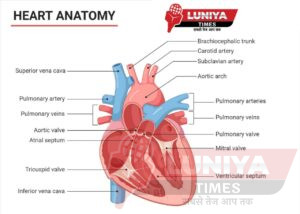
Lung Anatomy and Function
Exploring Lung Anatomy and Function: The Breath of Life
The human respiratory system is a marvel of biological engineering, with lungs playing a pivotal role in sustaining life. Beyond their apparent function of drawing in oxygen and expelling carbon dioxide, lungs are intricate organs with a complex structure finely tuned to facilitate efficient gas exchange. In this article, we delve into the anatomy and function of lungs, unraveling the secrets behind our ability to breathe.
Anatomy of the Lungs:
1. Location and Structure:
- The lungs are paired organs situated within the thoracic cavity, flanking the heart.
- Each lung is enclosed within a pleural cavity, surrounded by a double-layered membrane called the pleura.
- Structurally, lungs consist of bronchi, bronchioles, and alveoli.
2. Bronchial Tree:
- The bronchial tree begins with the trachea, which bifurcates into the left and right primary bronchi.
- These bronchi further divide into secondary bronchi, which then branch into smaller tertiary bronchi.
- The bronchi eventually give rise to bronchioles, which terminate in clusters of air sacs called alveoli.
3. Alveoli:
- Alveoli are the primary sites of gas exchange in the lungs.
- These tiny sacs are surrounded by a network of capillaries, facilitating the diffusion of oxygen into the bloodstream and the removal of carbon dioxide from the blood.
- With millions of alveoli in each lung, the surface area available for gas exchange is extensive, maximizing efficiency.
Function of the Lungs:
1. Pulmonary Ventilation:
- Pulmonary ventilation, commonly known as breathing, involves two phases: inhalation and exhalation.
- During inhalation, the diaphragm and intercostal muscles contract, expanding the thoracic cavity and lowering air pressure within the lungs, causing air to rush in.
- Exhalation occurs as the diaphragm and intercostal muscles relax, reducing thoracic cavity volume and expelling air from the lungs.
2. Gas Exchange:
- Gas exchange occurs in the alveoli, where oxygen from inhaled air diffuses across the alveolar membrane into the bloodstream.
- Simultaneously, carbon dioxide diffuses from the bloodstream into the alveoli to be expelled during exhalation.
- This process is driven by differences in partial pressures of oxygen and carbon dioxide between the alveoli and the blood.
3. Regulation of Blood pH:
- The lungs play a crucial role in maintaining acid-base balance in the body by regulating blood pH.
- Carbon dioxide, a byproduct of cellular metabolism, can combine with water to form carbonic acid, contributing to acidity.
- By adjusting the rate and depth of breathing, the lungs help regulate carbon dioxide levels in the blood, thereby controlling blood pH.
4. Defense Mechanisms:
- Lungs employ various defense mechanisms to protect against harmful pathogens and particles.
- Mucus produced by goblet cells lines the airways, trapping foreign particles and facilitating their removal via ciliary action.
- Additionally, specialized immune cells in the lungs, such as macrophages, engulf and neutralize invading microorganisms.
Clinical Significance:
Understanding lung anatomy and function is crucial for diagnosing and treating respiratory disorders and diseases. Conditions such as asthma, chronic obstructive pulmonary disease (COPD), pneumonia, and lung cancer can impair lung function, leading to breathing difficulties and other serious complications. Medical professionals utilize techniques such as pulmonary function tests, imaging studies, and bronchoscopy to assess lung health and guide treatment interventions.
Conclusion
the lungs are remarkable organs that enable the vital process of respiration, supplying oxygen to the body’s cells while removing waste carbon dioxide. Their intricate structure and coordinated function exemplify the elegance of biological systems. By unraveling the mysteries of lung anatomy and function, we gain insights into the delicate balance that sustains life itself.
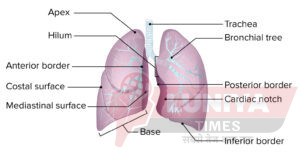
Liver Anatomy and Function
Understanding Liver Anatomy and Function: The Powerhouse Organ
Introduction:
The liver stands as one of the most remarkable organs in the human body, performing a myriad of vital functions essential for life. Situated in the upper right portion of the abdominal cavity, this reddish-brown, wedge-shaped organ plays a crucial role in metabolism, digestion, detoxification, and immune regulation. Understanding its anatomy and functions is pivotal in comprehending the intricate workings of the human body.
Anatomy of the Liver:
The liver is a large glandular organ with a weight averaging around 1.5 kilograms in adults. It is divided into four lobes: the right lobe, left lobe, caudate lobe, and quadrate lobe. These lobes are further divided into smaller lobules, which are the functional units of the liver. Blood enters the liver through two main vessels: the hepatic artery, which supplies oxygen-rich blood, and the portal vein, which carries nutrient-rich blood from the digestive organs. These vessels branch into smaller vessels and eventually into sinusoids, specialized capillaries within the lobules where the exchange of substances between blood and liver cells occurs.
Function of the Liver:
The liver performs a multitude of essential functions that are vital for maintaining homeostasis and overall health:
1. Metabolism: The liver is the metabolic hub of the body, regulating the metabolism of carbohydrates, fats, and proteins. It stores glucose in the form of glycogen and releases it when blood sugar levels drop. Additionally, it synthesizes important proteins such as albumin, which helps maintain blood volume, and clotting factors essential for blood coagulation.
2. Detoxification: One of the liver’s primary functions is detoxification, where it neutralizes and removes harmful substances from the bloodstream. It metabolizes drugs, alcohol, and other toxins, converting them into less harmful compounds that can be excreted by the kidneys or eliminated in bile.
3. Bile Production: The liver produces bile, a greenish-yellow fluid that aids in the digestion and absorption of fats in the small intestine. Bile is stored in the gallbladder and released into the duodenum (the first part of the small intestine) when needed to emulsify fats and facilitate their breakdown by digestive enzymes.
4. Storage: The liver serves as a reservoir for various nutrients and vitamins, including vitamins A, D, E, K, and B12, as well as iron and copper. These stored nutrients can be released into the bloodstream as needed to meet the body’s demands.
5. Immune Function: The liver plays a crucial role in the body’s immune system by filtering blood and removing pathogens, bacteria, and foreign particles. It also produces immune factors such as interleukins and interferons, which help regulate immune responses and defend against infections.
6. Synthesis of Hormones: The liver synthesizes hormones and other signaling molecules involved in various physiological processes, including the regulation of metabolism, growth, and reproduction.
Conclusion:
The liver’s intricate anatomy and multifaceted functions underscore its importance as a vital organ essential for life. From metabolism to detoxification, bile production to immune regulation, the liver performs a multitude of indispensable tasks that are central to maintaining overall health and well-being. Understanding the anatomy and functions of the liver not only enhances our appreciation for the complexity of the human body but also underscores the importance of maintaining liver health through proper nutrition, lifestyle choices, and regular medical check-ups.
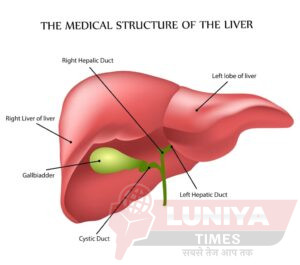
Kidney Anatomy and Function
Understanding the Marvels of Kidney Anatomy and Function
Introduction:
Kidneys, those unassuming bean-shaped organs nestled beneath our ribcage, are unsung heroes of our body’s intricate machinery. Often overshadowed by more glamorous organs, kidneys play a crucial role in maintaining our health by filtering waste products and excess fluids from the blood. Let’s embark on a journey to explore the anatomy and functions of these remarkable organs.
Anatomy of the Kidneys:
Each human typically possesses two kidneys, located on either side of the spine. Structurally, kidneys consist of three main regions: the renal cortex, renal medulla, and renal pelvis.
1. Renal Cortex:
The outer layer of the kidney is called the renal cortex. It contains millions of tiny filtering units called nephrons, which are the functional units of the kidneys responsible for filtering blood and producing urine.
2. Renal Medulla:
Beneath the renal cortex lies the renal medulla, which comprises renal pyramids. These pyramids contain tubules that collect urine from the nephrons and transport it to the renal pelvis.
3. Renal Pelvis:
The renal pelvis is the innermost region of the kidney, where urine is collected before it flows into the ureter and eventually exits the body.
Functions of the Kidneys:
The kidneys perform several vital functions that are essential for maintaining homeostasis and overall health:
1. Filtration of Waste Products:
One of the primary functions of the kidneys is to filter waste products and excess substances from the bloodstream. This process occurs in the nephrons, where blood is filtered through tiny clusters of blood vessels called glomeruli. Waste products, such as urea, uric acid, and creatinine, are removed from the blood and excreted in the urine.
2. Regulation of Fluid Balance:
The kidneys play a crucial role in regulating the body’s fluid balance by adjusting the volume and composition of urine produced. They selectively reabsorb water and essential electrolytes, such as sodium, potassium, and calcium, back into the bloodstream while excreting excess water and electrolytes as urine.
3. Maintenance of Blood Pressure:
Through the renin-angiotensin-aldosterone system (RAAS), the kidneys help regulate blood pressure by controlling the balance of salt and water in the body. When blood pressure drops, the kidneys release renin, an enzyme that initiates a series of biochemical reactions to increase blood pressure by constricting blood vessels and retaining sodium and water.
4. Production of Hormones:
The kidneys secrete several hormones that play crucial roles in various physiological processes. These hormones include erythropoietin, which stimulates the production of red blood cells in the bone marrow, and calcitriol, the active form of vitamin D, which regulates calcium and phosphate levels in the body.
Conclusion:
The kidneys are remarkable organs with multifaceted functions that are vital for maintaining health and well-being. From filtering waste products and regulating fluid balance to producing hormones that support essential bodily functions, the kidneys perform an array of intricate tasks that are indispensable for our survival. Understanding the anatomy and functions of the kidneys underscores the importance of nurturing and preserving these vital organs for optimal health throughout life.
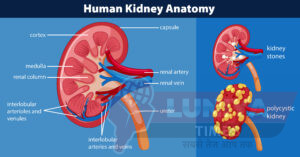
Stomach Anatomy and Function
Unveiling the Marvels of Stomach Anatomy and Function
Introduction:
The stomach, that humble yet powerful organ nestled within our abdomen, is an indispensable player in the intricate symphony of human digestion. Beyond its role as a mere storage pouch for food, the stomach orchestrates a complex series of biochemical processes essential for breaking down food into nutrients that fuel our bodies. Let’s embark on a journey through the anatomy and functions of this remarkable organ.
Anatomy of the Stomach:
The stomach is a muscular organ located between the esophagus and the small intestine, occupying the upper-left quadrant of the abdomen. It’s divided into four main regions: the cardia, fundus, body, and pylorus. The cardia is the area surrounding the opening where the esophagus connects to the stomach. The fundus is the uppermost portion, which often balloons after a meal. The body is the central and largest part of the stomach, where most digestion occurs. Lastly, the pylorus is the lower section that connects to the small intestine.
The stomach wall consists of several layers of specialized tissues. The innermost layer, the mucosa, is lined with epithelial cells that secrete mucus, hydrochloric acid, and enzymes. Beneath the mucosa lies the submucosa, followed by the muscularis layer responsible for churning and mixing food with gastric juices. The outermost layer, the serosa, provides protection and support to the stomach.
Functions of the Stomach:
1. Storage: One of the primary functions of the stomach is to store food temporarily. Upon swallowing, food enters the stomach through the lower esophageal sphincter and is stored until it’s ready for further digestion in the small intestine.
2. Mechanical Digestion: Through rhythmic contractions known as peristalsis, the stomach mixes food with gastric juices, breaking it down into smaller particles. This mechanical action, facilitated by the stomach’s muscular walls, helps to increase the surface area for enzymatic digestion.
3. Chemical Digestion: Gastric glands within the stomach lining secrete gastric juice, a potent cocktail of hydrochloric acid, mucus, and digestive enzymes. Hydrochloric acid lowers the pH of the stomach, creating an acidic environment crucial for activating enzymes and breaking down proteins. Enzymes like pepsinogen are converted into pepsin, which begins the digestion of proteins into smaller peptides.
4. Absorption: While the stomach primarily serves as a site for digestion, limited absorption of certain substances does occur. Water, some electrolytes, and certain drugs, like alcohol and aspirin, can be absorbed directly through the stomach lining into the bloodstream.
5. Protection: The stomach’s acidic environment not only aids in digestion but also serves as a protective barrier against pathogens present in ingested food. Additionally, the mucus layer produced by gastric glands acts as a protective barrier, preventing the stomach’s acidic juices from damaging its own lining.
Disorders and Diseases:
Despite its resilience, the stomach is susceptible to various disorders and diseases. These may include gastritis (inflammation of the stomach lining), peptic ulcers (open sores in the stomach lining), gastroesophageal reflux disease (GERD), gastric cancer, and functional dyspepsia (chronic indigestion).
Conclusion:
The stomach, with its intricate anatomy and multifaceted functions, plays a pivotal role in the process of digestion and nutrient absorption. From storage to mechanical and chemical digestion, this remarkable organ ensures that ingested food is broken down into its constituent nutrients, ready to fuel the body’s vital functions. Understanding the anatomy and functions of the stomach not only fosters appreciation for the complexities of the human body but also underscores the importance of maintaining a healthy lifestyle to support optimal digestive health.
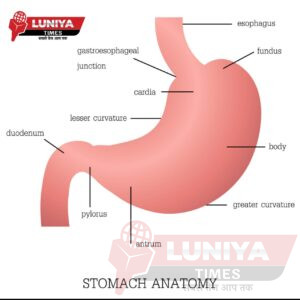
Small Intestine Anatomy and Function
Exploring the Marvels of Small Intestine: Anatomy and Function
Nestled within the intricate labyrinth of the digestive system lies the small intestine, an organ of remarkable complexity and vital importance. Despite its modest name, the small intestine plays a significant role in the process of digestion and nutrient absorption, serving as a crucial gateway between ingested food and the body’s internal environment. Let’s embark on a journey to unravel the anatomy and function of this remarkable organ.
Anatomy of the Small Intestine:
1. Length: Despite its name, the small intestine is not small in length. In fact, it measures around 6 to 7 meters (about 20 feet) in adults, making it the longest part of the digestive tract.
2. Divisions: Structurally, the small intestine is divided into three segments: the duodenum, jejunum, and ileum. The duodenum, the shortest segment, connects directly to the stomach. It receives partially digested food, bile, and pancreatic enzymes. The jejunum and ileum follow the duodenum, forming the bulk of the small intestine.
3. Microscopic Structure: Zooming in, the small intestine reveals a fascinating microscopic landscape. Its inner surface is lined with finger-like projections called villi, which increase the surface area available for nutrient absorption. Each villus is covered with even smaller projections called microvilli, further amplifying the absorptive capacity.
4. Blood Supply: To support its high metabolic activity, the small intestine receives a rich blood supply. Arteries, veins, and capillaries intricately weave through its tissues, ensuring efficient delivery of nutrients and oxygen.
Function of the Small Intestine:
1. Digestion: The small intestine is primarily responsible for the further digestion of food. Enzymes secreted by the pancreas and bile from the liver aid in breaking down complex carbohydrates, proteins, and fats into simpler molecules that can be readily absorbed.
2. Absorption: This is perhaps the most critical function of the small intestine. As the final frontier between ingested nutrients and the bloodstream, the small intestine absorbs essential nutrients such as carbohydrates, proteins, fats, vitamins, and minerals. The villi and microvilli greatly increase the surface area available for absorption, ensuring efficient nutrient uptake.
3. Secretion: In addition to absorbing nutrients, the small intestine also secretes hormones and mucus, which facilitate digestion and regulate various digestive processes. These secretions help maintain the optimal pH environment for enzyme activity and protect the delicate intestinal lining.
4. Immune Function: The small intestine is not just a passive conduit for nutrients; it also plays a crucial role in the body’s immune defense. Specialized immune cells located within the intestinal lining, such as lymphocytes and plasma cells, help prevent harmful substances from entering the bloodstream and mount immune responses against pathogens.
Disorders and Diseases:
Despite its resilience, the small intestine is susceptible to a variety of disorders and diseases. Conditions such as celiac disease, Crohn’s disease, and small intestinal bacterial overgrowth (SIBO) can impair its function, leading to malabsorption, nutrient deficiencies, and gastrointestinal symptoms.
Conclusion:
The small intestine may be often overlooked in discussions about the digestive system, but its significance cannot be overstated. From digestion and nutrient absorption to immune defense, this remarkable organ performs a myriad of essential functions that sustain life and wellbeing. Understanding its anatomy and function not only enriches our knowledge of human physiology but also underscores the importance of maintaining a healthy digestive system for overall health and vitality.
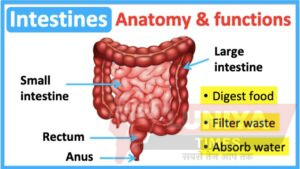
Join WhatsApp Group
Read Also
- 10 Best Topics on Human Body (Part 1)
- 3 Best Ideology in the world
- Best article for politics on 6 points
- 7 Best Comprehensive Guide to learn Kinemaster
- 1 Best article of “Who Was Bharat Ratna Pranab Kumar Mukherjee” Biography













2 Comments